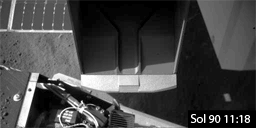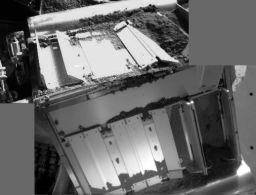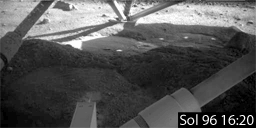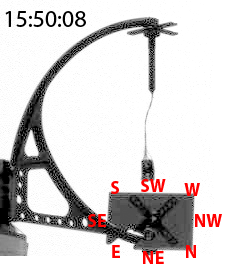Emily Lakdawalla • Sep 03, 2008
Phoenix update to sol 97: A new sample for wet chemistry and lots of fun with animations
It's time to catch up with the latest on the Phoenix mission at Mars, now more than a week into its extended mission. As I post this, we're a few hours in to sol 99. When I last checked in, Phoenix had spent a couple of weeks grooming trenches and preparing for sample deliveries. This week, they've delivered one sample to the Wet Chemistry Laboratory, tested out a new delivery method for getting an ice-rich sample into TEGA, and opened another set of TEGA doors. They've also done some neato imaging of the sky, and taken an interesting set of observations of that "Holy Cow" icy area under the lander very close to midnight.
Before I go on, it's probably a good idea for me to post an updated version of the work volume map; the only addition to the map I posted last week is Golden Goose 2.

The Phoenix 'work volume' as of sol 96
In the week prior to sol 96, Phoenix continued to prepare the Stone Soup and Snow White trenches for sample deliveries to MECA and TEGA, respectively. On sol 95, Phoenix scooped a large sample from the deep Stone Soup trench, called Golden Goose 2, and delivered it to the MECA Wet Chemistry Laboratory. A test sample was taken from Snow White; the next week should see a TEGA delivery.Pink text indicates the approximate locations of samples delivered to MECA, and green text indicates samples delivered to TEGA. Small gray text indicates named rocks.
The deliveries happened according to the following schedule:
ol 12: Baby Bear to TEGA 4 (in oven sol 16)
ol 30: Rosy Red to WCL 0
ol 41: Sorceress to WCL 1
ol 64: Wicked Witch to TEGA 0
ol 72: Rosy Red 3 to TEGA 5
ol 85: Burning Coals to TEGA 7
ol 96: Golden Goose to WCL 3
The base panorama consists of images captured on sol 84.

Delivery of 'Golden Goose 2' to MECA
On sol 96, Phoenix dropped a scoopful of soil onto the open hopper of the outermost of Phoenix' four Wet Chemistry Laboratory cells. The first image in this animation was taken on sol 90 and shows the empty hopper. The second shows the full scoop of soil, taken from the Stone Soup trench, poised over the Wet Chemistry Laboratory. In the third image, the soil has been dumped. The last two images were taken from closer in, and appear to document the behavior of the dumped pile as the sample drawer was closed, delivering the soil sample to the waiting beaker.I haven't heard anything from the mission about how they think the sample delivery went. In any case, they went ahead and opened another set of TEGA doors, the fifth to be opened, oven #1. The oven 1 doors opened the same way that 4 and 7 did -- one door opened completely, the other door partially. They've already demonstrated that they can get a small sample through doors opened in that configuration. Maybe it's time for a map of TEGA, too.

NASA / JPL / UA / MPI / collage by Emily Lakdawalla
The TEGA instrument as of sol 96
On sol 96, the doors were opened over TEGA oven 1 in preparation to receive a new sample, possibly an ice-rich one. This mosaic of two robotic arm camera images taken on sols 85 and 96 documents the current status of the instrument. The upper half of the instrument (as seen in this mosaic) includes, from left to right, ovens 7, 6, 5, and 4 (the last one is only partially visible). Three of these have been used; only oven 6 is still closed. The bottom half of the instrument includes, from left to right, ovens 3, 2, 1, and 0; ovens 3 and 2 remain unopened. To date, the only doors that have opened correctly and fully are those over oven 0. Ovens 1, 4, and 7 had one door open partially and one fully. Oven 5 had both doors open partially. Despite the door opening problems, the TEGA team has succeeded in getting samples inside every open oven, except the most recently opened one.
NASA / JPL / UA / Texas A & M
Clouds moving across Phoenix' sky
Phoenix took the 10 frames that compose this animation between 14:52 and 15:02 local solar time on sol 94. The camera was gazing slightly to the west of south, so the clouds are moving westward or west-northwestward. Ice clouds have become more common in Phoenix' sky as the summer sun causes water to sublime from the northern polar cap; the summer's maximum abundance of atmospheric water vapor was recently reached at the Phoenix site.
NASA / JPL / UA / animation by Emily Lakdawalla
Wind at noon on Phoenix sol 94
Phoenix frequently captures many images of the "telltale" atop the meteorological mast in order to study wind speed and direction at its landing site. The 64 images in this animation were captured over the course of about an hour near local noon, and document some of the largest excursions yet observed for the telltale, some of them right out of the image frame. The telltale is generally being blown toward the north and northwest, indicating winds coming from the south at that time of day.
NASA / JPL / UA / MPI / animation by Emily Lakdawalla
Holy Cow overnight, sols 96-97
Phoenix parked its arm in position to peek underneath itself at the site called "Holy Cow" over the night of sols 96 to 97. For all of the images, the Sun was above the horizon, but near midnight the Sun was nearly behind the camera, making the shadows nearly disappear.Support our core enterprises
Your support powers our mission to explore worlds, find life, and defend Earth. You make all the difference when you make a gift. Give today!
Donate

 Explore Worlds
Explore Worlds Find Life
Find Life Defend Earth
Defend Earth


